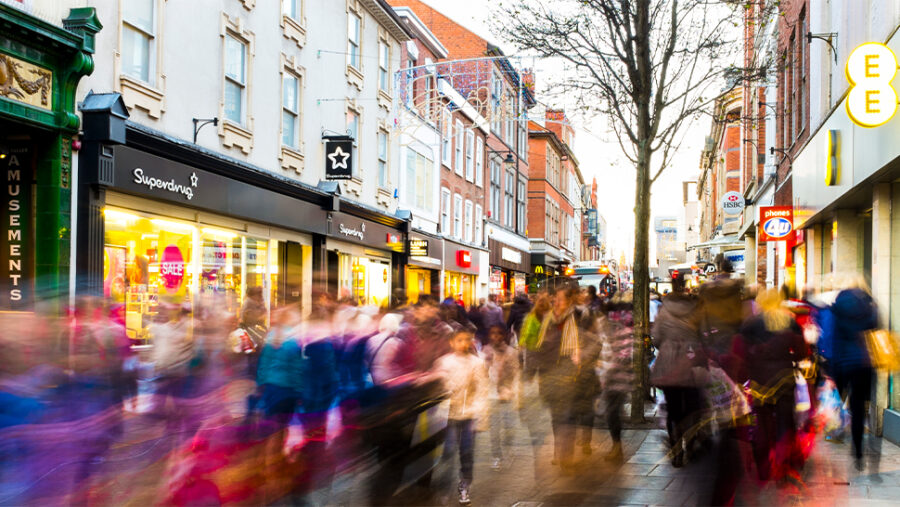

Although it is very sad news for Cheltenham, is the demise of Cavendish House a surprise? No, not really. It follows the failure of many well-known names including Wilko, Toys ‘R’ Us, HMV, BHS, Debenhams and the Body Shop.
History of Cavendish House
Cavendish “Cav” House is Cheltenham’s oldest department store. It first opened its doors in 1823 and was initially a small drapery store selling a selection of silks, muslins, shawls, gloves, lace and fancy goods. The shop flourished and continued to grow; by 1872 it occupied an extensive site along the Promenade, boasting more than twenty departments and additional workrooms. The store continued to be successful and was regularly refurbished and expanded over the following decades. By 1931 the store was over 163,000 square feet with the current 287-foot frontage on the Promenade. In 1970 Cavendish House became part of the House of Fraser group. The store has maintained its prominent reputation in Cheltenham and has drawn in millions of shop goers over the decades. After 201 years of trading, Cavendish House is finally closing its doors as House of Fraser seek to cut costs.
Cheltenham’s recent changes
Cheltenham High Street and the Promenade have witnessed significant changes over recent years. In 2017 the old Beechwood arcade was flattened to make way for the new John Lewis department store. The Brewery Quarter has become the new hub for restaurants and entertainment with over 15 places to eat and activities such as bowling, mini golf, darts and escape rooms. The Quadrangle, overlooking Imperial Gardens, has recently been gentrified to create a multi-use space incorporating restaurants and modern stylish offices, which have been developed alongside environmental considerations, such as solar panels and open green spaces for outdoor dining and entertainment. The Quadrangle has created a cohesive flow between the Promenade and Montpellier. We have also seen old shops such as New Look and HMV being developed into entertainment spaces such as Roxy Lanes and offices which overlook onto the High Street. It is clear there is a trend of converting old traditional retail spaces into multi-use buildings for entertainment and offices.
Why are high streets changing?
Firstly, the changing nature of a typical UK high street could be attributed to the increased demand for instant, easy and accessible shopping. Shopping in town centres can be restrictive due to costly parking and having to take time looking around multiple shops to find what you are after – although isn’t that the fun part? Online services, such as Amazon, allow you to instantly search for what you need; they typically offer a wider range of products and you can make purchases at a click of a button. Furthermore, there is no need to worry about parking or transport and websites have made it easy to return items. However, even some online operators have run into trouble recently with businesses including Wiggle and Made.com folding.
Secondly, the Covid-19 pandemic has had a significant impact on the nature of the high street. Many employees resorted to hybrid and at home working leading businesses to reduce office space. Four years on from when the pandemic started, staff are returning to offices. This has resulted in an increase in demand for office space and this has led to us seeing more properties in Cheltenham being converted to offices. The pandemic has also given businesses the opportunity and time to upgrade and refurbish their office spaces, much like HCR’s Cheltenham office. This has further led to businesses seeking new modern and upgraded office spaces like the Quadrangle.
Finally, there has been a resurgence in large multi-use business and retail parks which has impacted high streets. These sites are popular as they offer the convenience of free and flexible parking, better public transport links and multi-functional spaces for businesses of all kinds. We are also starting to see offices and leisure facilities, such as gyms, in these multi-use parks. This is interesting as it reflects how these spaces are being used. It allows individuals to stay the whole day in one location from going to the gym before work, working a day in the office and then visiting the shops and restaurants after work, all whilst having free and unlimited parking. It could be argued that retail and industrial parks are a winning formula due to their accessibility and convenience, and are here to stay. They often have lower rents with larger premises, allowing retail shops to have click-and-collect services to complement their increasing online orders. This is ultimately drawing businesses away from the high streets.
What is the future for Cavendish House?
The iconic extensive four storey building which employed almost 100 members of staff is set to close in April 2024. Many people are waiting in anticipation to see what the building will become. It is likely that such a large store would benefit from mixed-use development blending retail, leisure, entertainment, offices and even residential flats. This is an opportunity to inject new life into the Promenade by gentrifying and developing this iconic building for future generations.










